GEOG1290 section H: hydrologic cycle
1/119
There's no tags or description
Looks like no tags are added yet.
Name | Mastery | Learn | Test | Matching | Spaced |
|---|
No study sessions yet.
120 Terms
What is the hydrosphere (recap)
All of earths water, global water system
Key role of hydrosphere?
redistributing energy flows via atmospheric/oceanic circulation
What is the hydrosphere powered by
Radiant energy from the sun
Global distribution (total hydrosphere)?
97.2% saline (oceans, saltwater) & 2.8% fresh water (groundwater, glaciers)
What is the hydrologic cycle?
Movement of water between various storage locations (reservoirs)
Amount of water is infinite or finite?
Finite. Then total amount evaporated equals the total precipitated globally and local and regional imbalances occur
Name the studied properties or water in this section
Hydrogen bonding, thermal characteristics, latent heat
hydrogen bonding
Bond between H2O molecules due to slightly -ve Oxygen charge and slightly +ve Hydrogen charge
Properties of water - hydrogen bonding
Hydrogen bonding, cohesion, adhesion
Cohesion
H2O molecules attracted to each other
Adhesion
H2O is attracted to other substances
Thermal characteristics which affect properties of water?
When water cools, specific heat
Properties of water — When does water contract?
As water cools it contracts when cooling to 4°C
Properties of water — when does water expand ?
When cooling from 4°C to 0°C: ice floats on water - less dense compared to liquid water
Why is waters expansion important?
Important in weathering of rock
Waters specific heat (recap kinda)
Amount of energy required to raise the temperature of 1g of water 1°C: specific heat of 1 which is much higher than air, granite, sand and iron
Is it easier to raise the temperature of water or air?
Air, because it takes less energy. Airs specific heat is 0.24 and water’s is 1. Meaning it takes almost 5x as much energy to raise the temperature of 1g of water by 1°C than to raise temp of 1g of air by 1°C
What is latent heat (recap)
The amount of energy that is absorbed or released when a substance changes states (without a change in temperature) latent heat forms or breaks molecular bonds
Phase changes of water are accompanied by the exchange of ____________ .
Latent heat
When latent heat (energy) is released what might occur to water?
Freezing, condensation, deposition
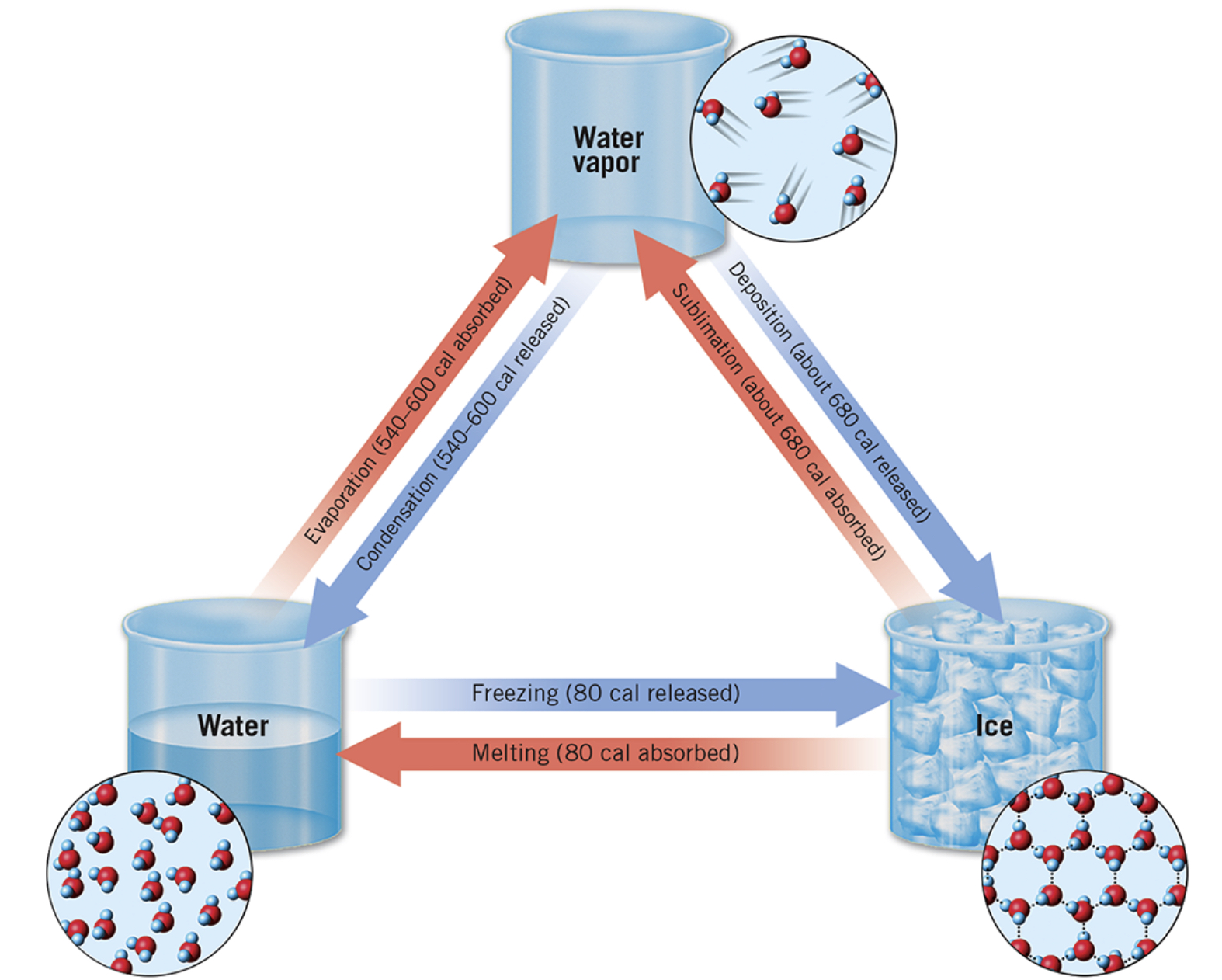
When latent heat (energy) is absorbed, what might occur to water?
Melting, evaporation, sublimation


What is this image showing?
Energy input and temperature changes of water
Evaporation
Transformation of liquid water into water vapour
Transpiration
Loss of water vapour directly from leaf pores (stomates) in plants into the atmosphere
Evapotranspiration
Evaporation + transpiration

What do evapotranspiration rates depend on?
Net radiation, air temperature, relative humidity and moisture capacity of air, wind speed
What effect does net radiation have on evapotranspiration rates?
Increases heating
What effect does air temperature have on evapotranspiration rates?
Influences maximum humidity
Humidity
Amount of water vapour in the air
Humidity varies both..
Spatially and temporally
Measures of humidity (4)
Vapour pressure, specific humidity, relative humidity, dew-point temperature
Precipitable water
Measurement of how much moisture could theoretically precipitate given the right conditions
Water vapour pressure gradient
Water vapour moves from H to L vapour pressure
Where are H and L vapour pressure found?
High vapour pressure: close to water surface & Low vapour pressure at higher altitudes
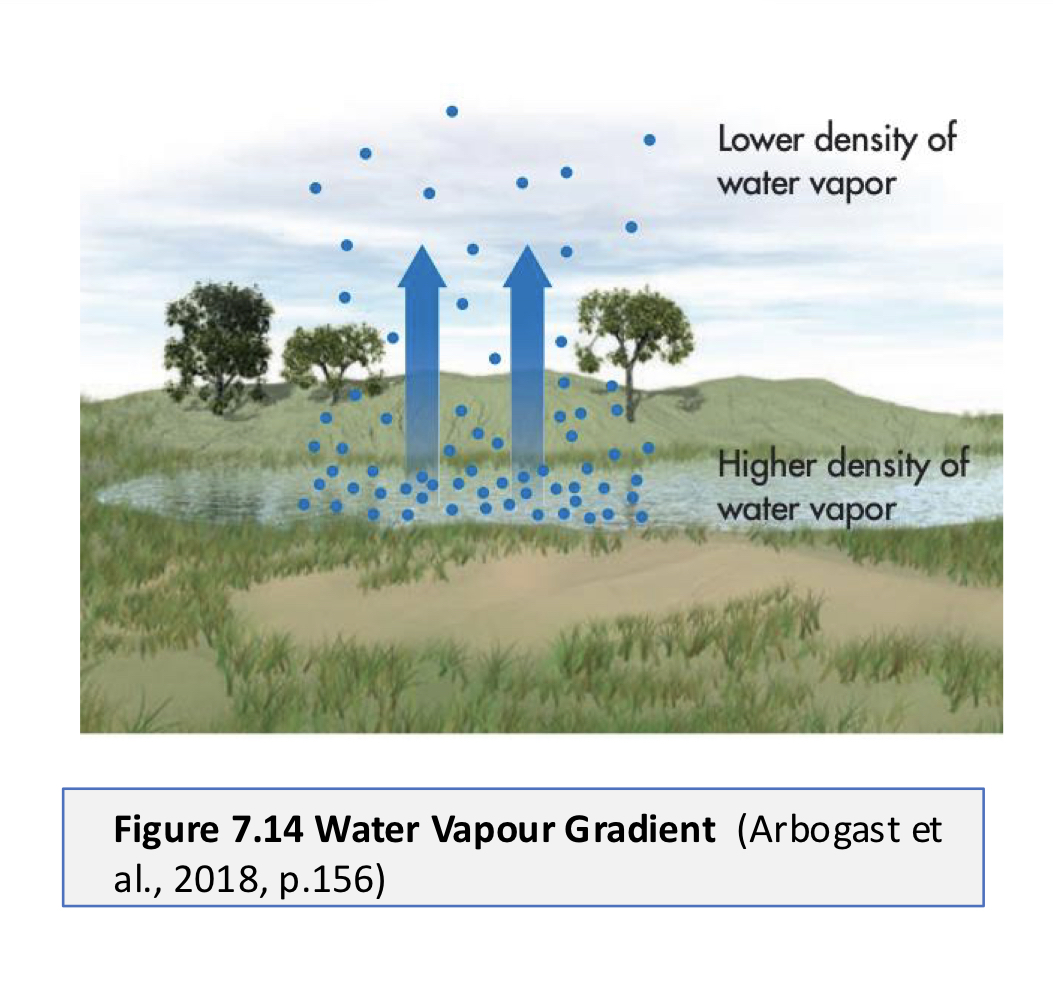
What can affect water vapour pressure gradient?
Wind, it can move moist air away from the source (ex) away from water)
Humidity and air temperature
Warm air can hold much more water than cold air
How much water vapour can cold dry air hold?
Can have close to 0% water vapour
How much water vapour can warm tropic air have?
May have 4-5% water vapour
When measuring water vapour, what is specific humidity?
Actual amount of water vapour in a given amount of air
Ex) 10 grams of H2O vapour in 1kg of air
Measured in g/kg
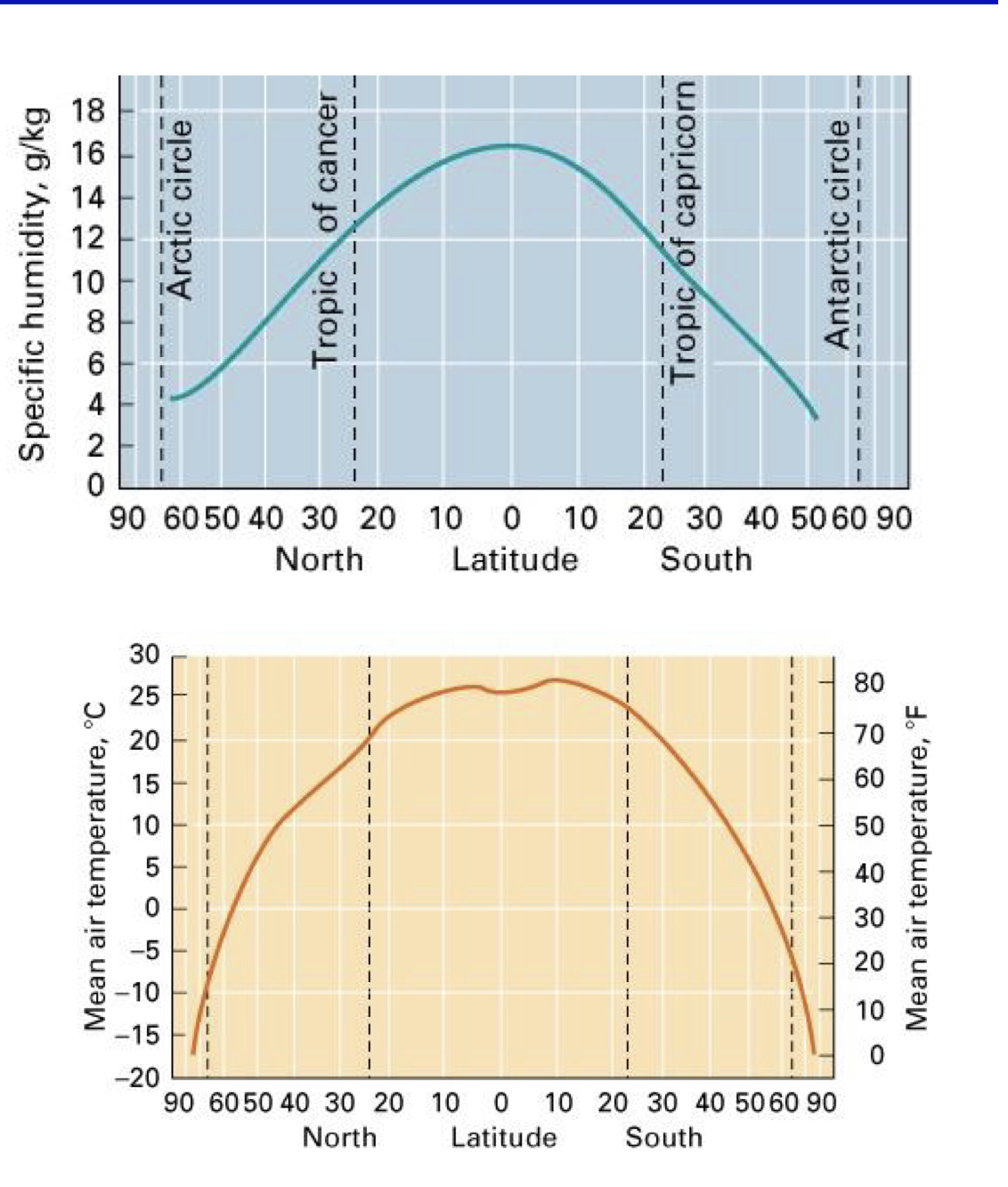
When measuring water vapour what is maximum specific humidity? Unit of measurement?
Maximum amount of H2O vapour that a body of air can hold at its current temperature. G/kg
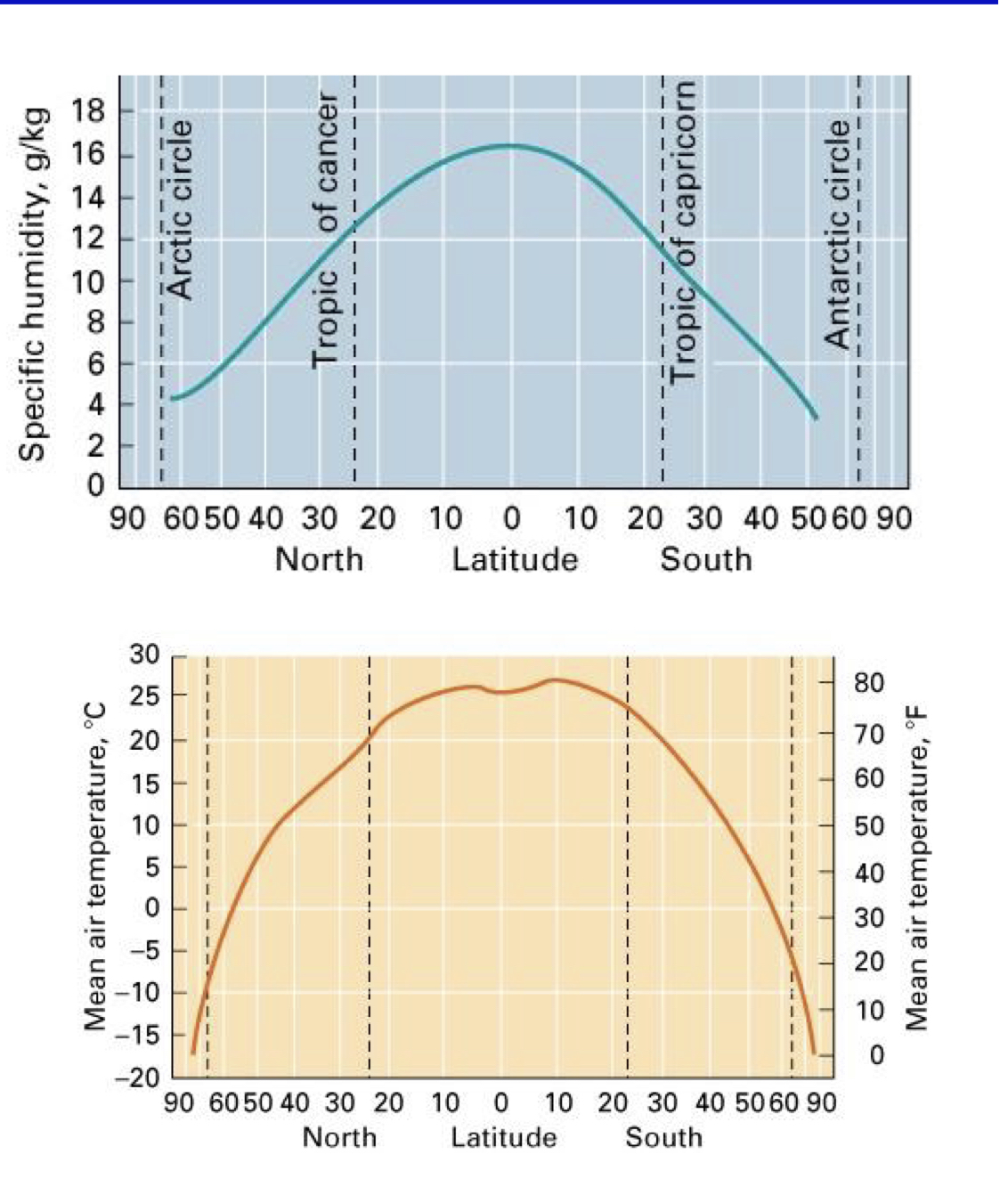
What is the saturation curve?
The saturation curve describes the relationship between maximum humidity and temperature, maximum humidity rises with temperature.
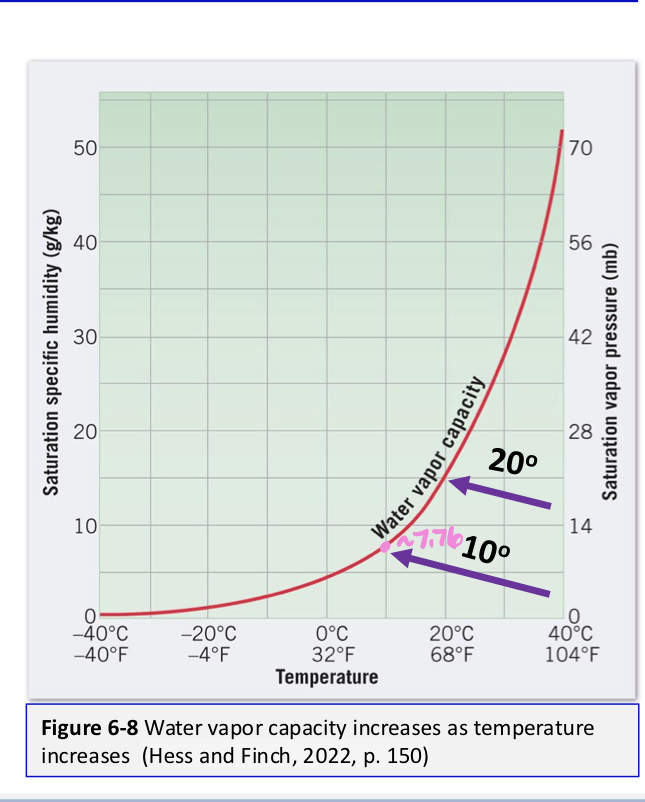
What is relative humidity?
RH is what we see on weather apps, the percentage of actual water vapour in the air compared to the maximum amount the air COULD hold, at that temperature. Describes how close air is to saturation at its current temperature.
Saturation depends on..?
Temperature
If RH is 50% what does this mean? Is the air saturated?
This means the air is holding 50% of humidity that it COULD hold/ in relation to its maximum capacity at that temperature. It is not saturated (saturated only at 100%).
Relative humidity changes with change in:
Temperature and water vapour gain/loss
How does temperature affect RH?
Changes the maximum specific (actual amount of) humidity.
How do water vapour changes (gains/losses) affect RH?
Change the specific humidity (the actual amount of humidity in the air)
How do you calculate relative humidity ?
Specific humidity divided by / maximum specific humidity times x 100
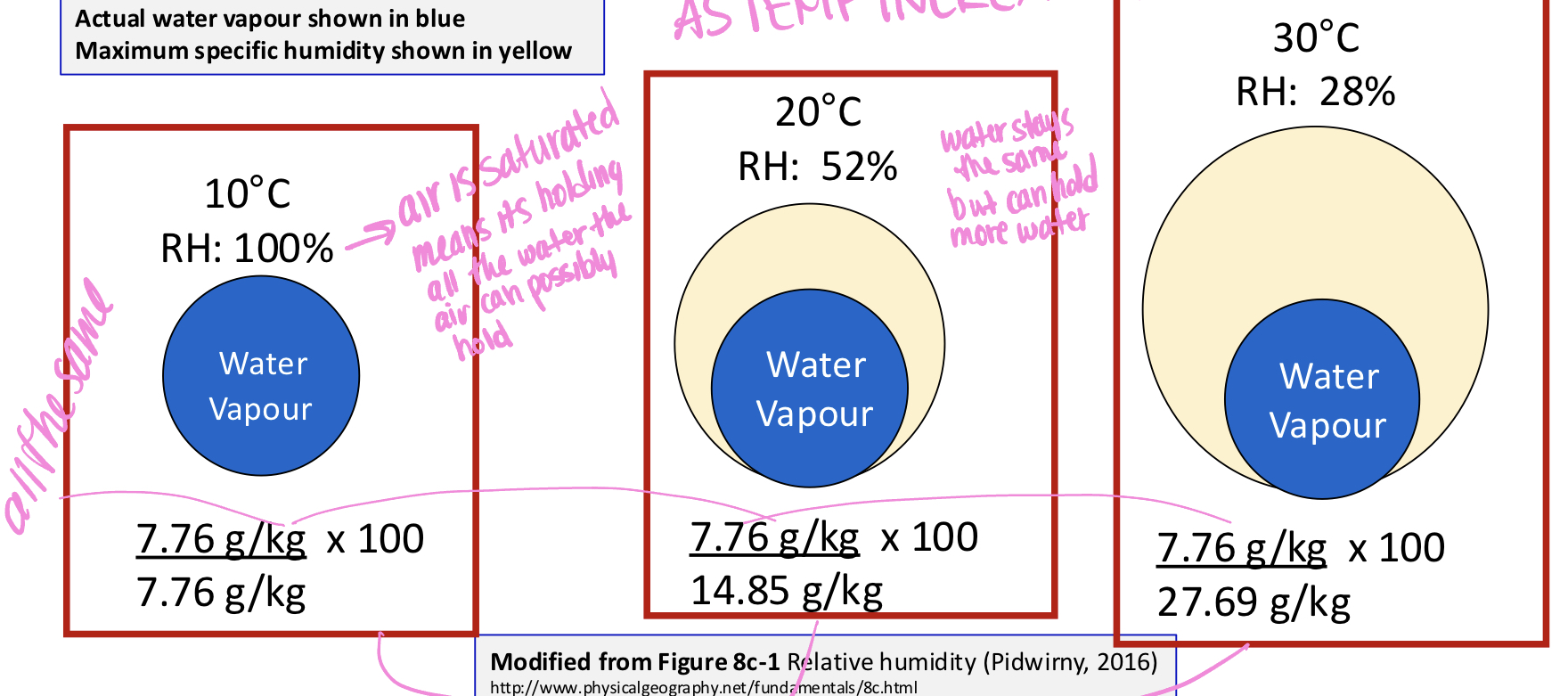
If relative humidity is 100%, air is ___?
Saturated

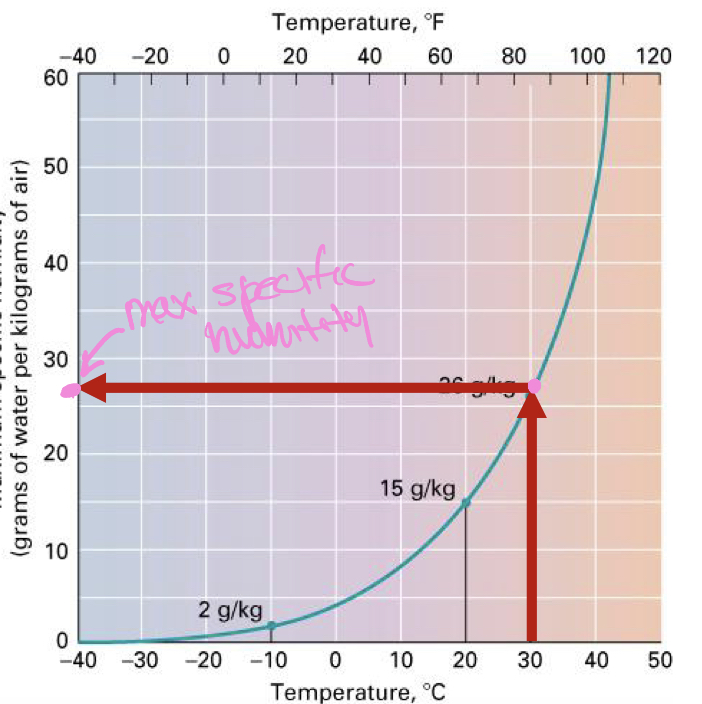
(Example: relative humidity) a parcel of air has a specific humidity of 7.5 g/kg and its air temperature is 30°C. Calculate the relative humidity:
RH= SH (7.5)/MaxH(26)x100 = 28.8 (29%)
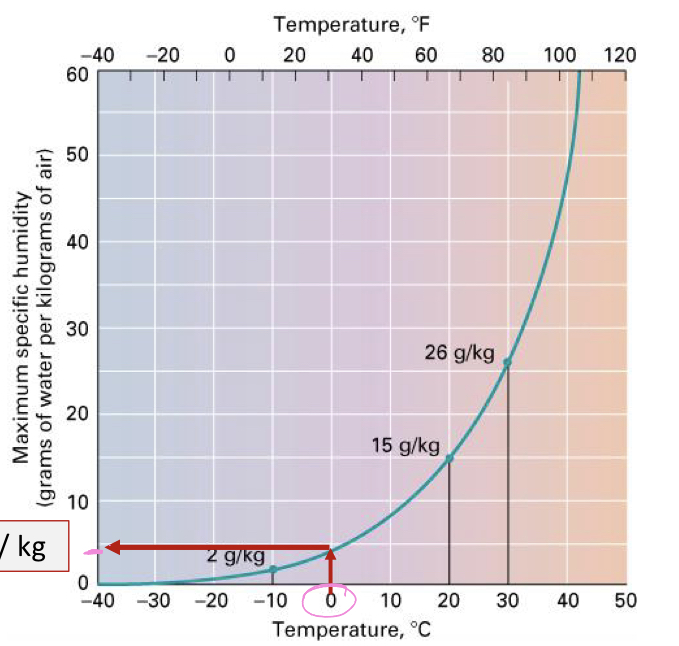
Find maximum specific humidity at 0°C
4g/kg
What relationship does temperature have with relative humidity
Inverse… meaning when temp goes up→ RH goes down and vice versa
What does heating of air do to RH
Temp increase so → RH decrease (bc hot air holds more humidity, higher max)

What does cooling of air do to RH
Temp decrease so → RH increase (cold air can hold LESS humidity)
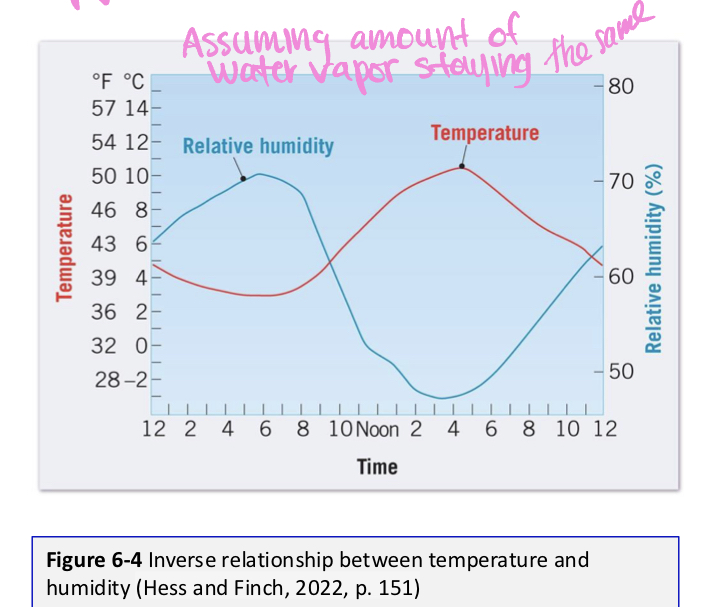
Humidity global patterns (high vs low latitudes)
Lower latitudes → Specific humidity (direct measure) is HIGH (hotter, low pressure zone)/ relative humidity LOW (bc air CAN hold more)
Higher latitudes → specific humidity LOW (colder temperature)/ relative humidity is HIGH (closer to saturation bc the air cant hold as much moisture as in the hot areas)
Relative humidity is ___ in the low latitudes.
Low
Specific humidity is ___ in the higher latitudes.
Low
Specific humidity is __ in the low latitudes.
High
Relative humidity is ___ in the high latitudes.
High
Atmospheric stability depends on
1 Relative temperature
2 density
What does atmospheric stability describe?
What Isi happening to vertical movements of air. The temperature of a parcel of air compared with surrounding atmosphere
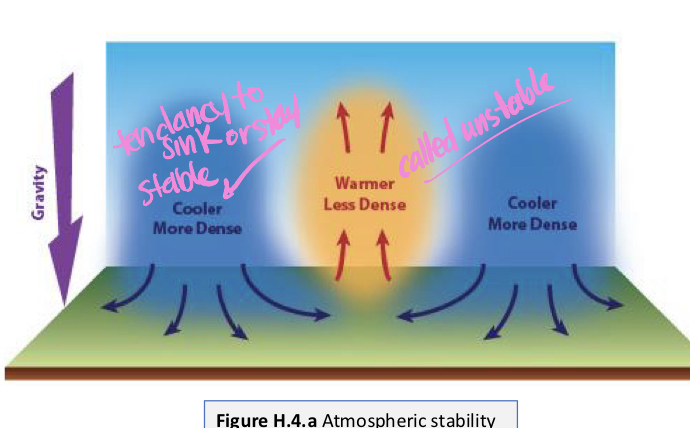
Cooler more dense air that has a tendency to sink or stay is considered/ called ____.
Stable
Warmer less dense air with a tendency to rise is called ____
Unstable
What are clouds?
Visible masses of tiny suspended water droplets or ice crystals (fog)
What are the two necessary conditions for cloud formation?
1) air must be saturated (100% RH) either by cooling to dew point or adding water vapour to the air
2) there must be a substantial amount of hygroscopic condensation nuclei (small aerosols) for water vapour to collect
What is dew point
When air is cooled to a point where condensation happens
Something that is hygroscopic…
Attracts water (ex: condensation nuclei)
What are some examples of hygroscopic condensation nuclei? What do they do?
Dust, sea-salts, etc. They attract water and create raindrops because the water uses them as a surface (tiny) and collects around it
Do all clouds precipitate?
No, but all precipitation comes from clouds.
How many cloud types are there?
10, based on form and height (altitude they are at)
Name the 4 forms of clouds
1 — Cirro-form (two types)
2 — Cumulo-form
3 — Strato-form
4 — Nimbo-form (two types)
What are Cirro-form clouds?
Clouds made of ice crystals, high elevation, whispy clouds
Two types
Ex) cirrus / cirrostratus (refraction of ice crystals, sundogs)
What are Cumulo-form Clouds ?
Taller than wide clouds, puffy and fluffy
Cumulus
What are strato-form clouds?
Blankets, layers of clouds, range from dark grey to white
Stratus
What are Nimbo-form clouds?
Nimb=precipitation
Two types of precipitation clouds:
Nimbostratus → everyday rain clouds
Cumulonimbus → thunder and lightning
What are the four cloud heights (altitude)
Low, middle (alto), high (cirrus), vertically developed
Where are low clouds?
0-2km high
Where are middle (alto) clouds ?
2-6km high
Where are high clouds ?
Above 6km high
Where are vertically developed clouds?
Closer to the surface, but range, cumulus and cumulonimbus
What causes sun dogs ?
Refraction of sunlight by the hexagonal ice crystals in cirrus and cirrostratus clouds. These clouds act as prisms
When do sundogs typically occur?
When sun is close to the horizon and there are cirrus clouds or fog, colder days
What causes rainbows?
Sunlight striking liquid drops rather than ice crystals
When does precipitation occur
When cloud droplets or ice crystals grow large enough to overcome updrafts and fall to the earth
Which clouds precipitate
Nimbostratus and cumulonimbus
What is rain
Liquid H2O droplets
What is snow
Ice crystals
What is sleet?
Rain that freezes before hitting the ground (same as hail just smaller)
What is freezing rain
Rain that freezes when it/on impact with the ground
What is hail
Ice crystals that melt and freeze before falling
What is Virga
Rain that evaporates before reaching the ground
what is a necessity for precipitation?
Water or ice droplets large/heavy enough to fall through the cloud. One million cloud droplets needed to form a rain drop heavy enough to fall to earth
How is raindrop shape determined?
Drop size (smaller, less jelly beanie)
Air resistance (air pushing up on it as it falls making it shape more like a jelly bean)
Not teardrop shaped
where does precipitation originate?
From parcels of moist air that have been Adiabatic ally cooled
Where do condensation and cloud formation start?
At the lifting condensation level (LCL)
How does Adiabatic cooling occur?
Through the lifting of air from the surface to higher levels in the atmosphere.
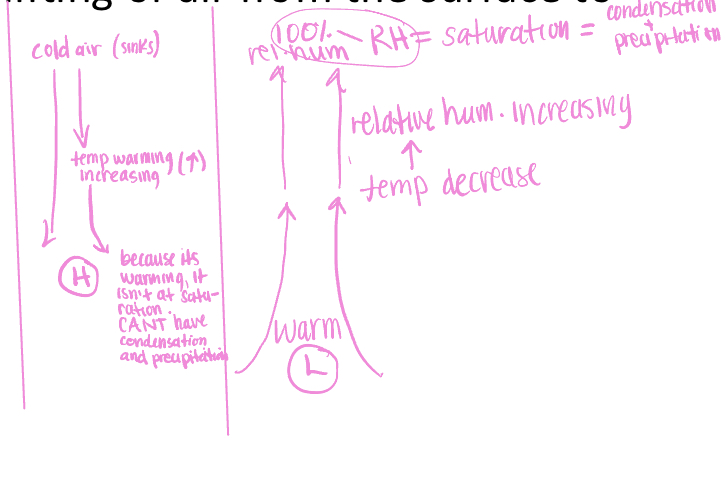
What are the four ways air is lifted to higher levels of the atmosphere which cause Adiabatic cooling ?
1 convective uplift
2 orographic uplift
3 convergent uplift
4 frontal (cyclonic) uplift
How does convective uplift happen ?
unstable parcel of air rises on its own until 100% precipitation.
Happens on its own, no external force applied, spontaneous
Why does convective uplift occur ?
Unequal heating of surface causes air parcel to rise and expand
What happens during convective uplift?
The pressure of unstable air (hot air, rising) goes down as it rises and air cools adiabatically. Condensation occurs at LCL (lifting condensation level)